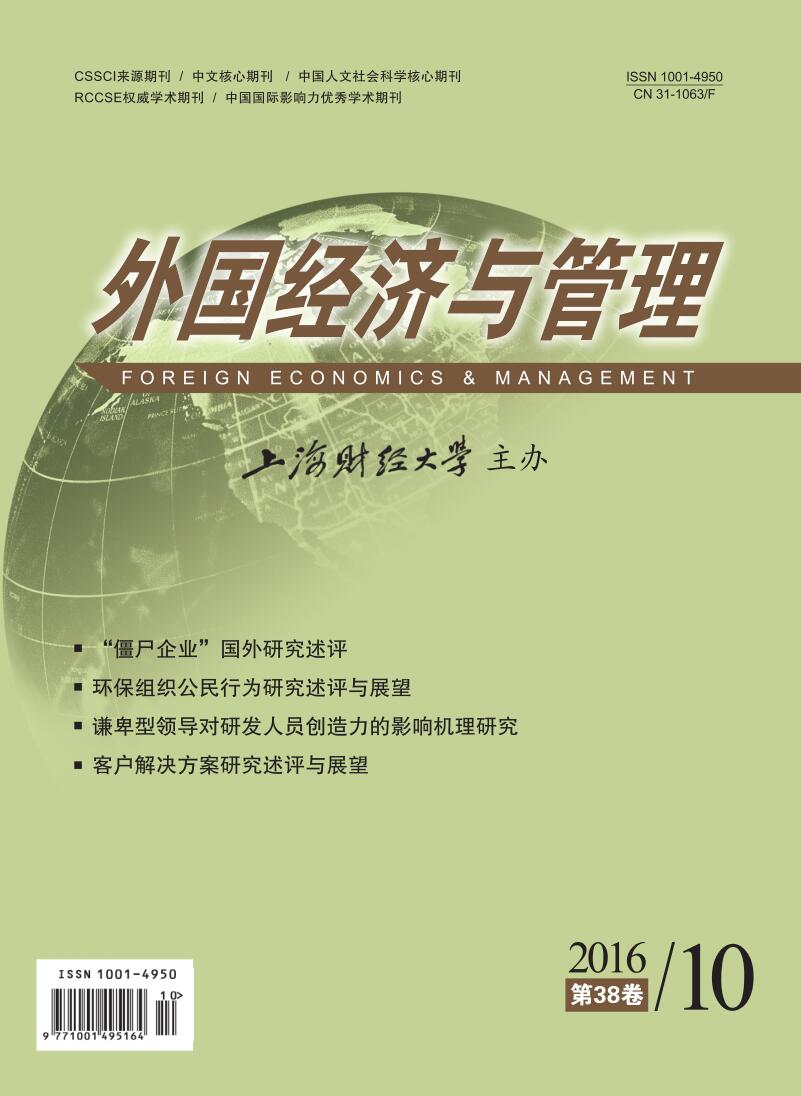本文基于企业行为理论和前景理论,结合“威胁-刚性”假说的观点,分析了企业面临破产威胁的程度与战略变革实施之间的关系,并讨论了组织内部资源(冗余资源和政治资本)和外部市场机会(市场丰腴性)对两者关系的调节作用。基于2003-2014年中国沪深A股上市公司的数据,得到以下研究结论:(1)随着破产威胁程度的不断提高,企业进行战略变革的程度呈现出先升后降的倒U形关系;(2)企业拥有的冗余资源越多,说明企业现有的进行战略变革的内部基础条件越丰富,增强了企业在面临破产威胁时进行战略变革的能力;(3)政治资本作为企业能够获得未来潜在资源的依靠,为企业战略变革提供了更多资源基础,进一步强化了破产困境下企业实施战略变革的能力;(4)丰腴的外部市场为企业提供了良好的外部经营环境和更多的环境自主权,进一步强化了面临破产威胁困境的企业进行战略变革的程度。本文有助于从经营困境视角解释破产威胁与战略变革间的复杂关系,丰富了破产威胁和战略变革等方面的相关研究。
破产威胁与战略变革——基于组织资源与市场丰腴性的调节效应研究
摘要
参考文献
5 Aldrich H E, Wiedenmayer G. From traits to rates:An ecological perspective on organizational foundings[A]. Katz J, Brockhaus R. Advances in Entrepreneurship, Firm Emergence, and Growth[M]. JAI Press Inc., 1993, 1:145-196.
6 Audia P G, Greve H R. Less likely to fail:Low performance, firm size, and factory expansion in the shipbuilding industry[J]. Management Science, 2006, 52(1):83-94. DOI:10.1287/mnsc.1050.0446
7 Baum J A C, Dahlin K B. Aspiration performance and railroads' patterns of learning from train wrecks and crashes[J]. Organization Science, 2007, 18(3):368-385. DOI:10.1287/orsc.1060.0239
8 Bettis R A. Performance differences in related and unrelated diversified firms[J]. Strategic Management Journal, 1981, 2(4):379-393. DOI:10.1002/(ISSN)1097-0266
9 Boubakri N, Cosset J C, Saffar W. Political connections of newly privatized firms[J]. Journal of Corporate Finance, 2008, 14(5):654-673. DOI:10.1016/j.jcorpfin.2008.08.003
10 Chen W R, Miller K D. Situational and institutional determinants of firms' R & D search intensity[J]. Strategic Management Journal, 2007, 28(4):369-381. DOI:10.1002/(ISSN)1097-0266
11 Cyert R M, March J G. A behavioral theory of the firm[M]. Englewood Cliffs, NJ:Prentice-Hall, 1963.
12 Finkelstein S, Hambrick D C. Top-management-team tenure and organizational outcomes:The moderating role of managerial discretion[J]. Administrative Science Quarterly, 1990, 35(3):484-503. DOI:10.2307/2393314
13 Gentry R J, Shen W. The impacts of performance relative to analyst forecasts and analyst coverage on firm R & D intensity[J]. Strategic Management Journal, 2013, 34(1):121-130. DOI:10.1002/smj.2013.34.issue-1
14 Greve H R. A behavioral theory of R & D expenditures and innovations:Evidence from shipbuilding[J]. Academy of Management Journal, 2003a, 46(6):685-702. DOI:10.2307/30040661
15 Greve H R. Organizational learning from performance feedback:A behavioral perspective on innovation and change[M]. Cambridge:Cambridge University Press, 2003b.
16 Gruber J S. Key principles of community-based natural resource management:A synthesis and interpretation of identified effective approaches for managing the commons[J]. Environmental Management, 2010, 45(1):52-66. DOI:10.1007/s00267-008-9235-y
17 Kahneman D, Tversky A. Prospect theory:An analysis of decision under risk[J]. Econometrica, 1979, 47(2):263-292. DOI:10.2307/1914185
18 Keats B W, Hitt M A. A causal model of linkages among environmental dimensions, macro organizational characteristics, and performance[J]. Academy of Management Journal, 1988, 31(3):570-598. DOI:10.2307/256460
19 Kraatz M S, Zajac E J. How organizational resources affect strategic change and performance in turbulent environments:Theory and evidence[J]. Organization Science, 2001, 12(5):632-657. DOI:10.1287/orsc.12.5.632.10088
20 Lehman D W, Hahn J, Ramanujam R, et al. The dynamics of the performance-risk relationship within a performance period:The moderating role of deadline proximity[J]. Organization Science, 2011, 22(6):1613-1630. DOI:10.1287/orsc.1100.0626
21 Levinthal D, March J G. A model of adaptive organizational search[J]. Journal of Economic Behavior & Organization, 1981, 2(4):307-333.
22 Li J T, Tang Y. CEO hubris and firm risk taking in China:The moderating role of managerial discretion[J]. Academy of Management Journal, 2010, 53(1):45-68. DOI:10.5465/AMJ.2010.48036912
23 McKinley W, Latham S, Braun M. Organizational decline and innovation:Turnarounds and downward spirals[J]. Academy of Management Review, 2014, 39(1):88-110. DOI:10.5465/amr.2011.0356
24 Miller D, Toulouse J M. Chief executive personality and corporate strategy and structure in small firms[J]. Management Science, 1986, 32(11):1389-1409. DOI:10.1287/mnsc.32.11.1389
25 Nakauchi M, Wiersema M F. Executive succession and strategic change in Japan[J]. Strategic Management Journal, 2015, 36(2):298-306. DOI:10.1002/smj.2255
26 Romanelli E, Tushman M L. Inertia, environments, and strategic choice:A quasi-experimental design for comparative-longitudinal research[J]. Management Science, 1986, 32(5):608-621. DOI:10.1287/mnsc.32.5.608
27 Staw B M, Sandelands L E, Dutton J E. Threat rigidity effects in organizational behavior:A multilevel analysis[J]. Administrative Science Quarterly, 1981, 26(4):501-524. DOI:10.2307/2392337
28 Tarus D K, Aime F. Board demographic diversity, firm performance and strategic change:A test of moderation[J]. Management Research Review, 2014, 37(12):1110-1136. DOI:10.1108/MRR-03-2013-0056
29 Westphal J D, Bednar M K. Pluralistic ignorance in corporate boards and firms' strategic persistence in response to low firm performance[J]. Administrative Science Quarterly, 2005, 50(2):262-298.
30 Zhang Y, Rajagopalan N. Once an outsider, always an outsider? CEO origin, strategic change, and firm performance[J]. Strategic Management Journal, 2010, 31(3):334-346. DOI:10.1002/smj.v31:3
引用本文
连燕玲, 刘俊良, 陈琼. 破产威胁与战略变革——基于组织资源与市场丰腴性的调节效应研究[J]. 外国经济与管理, 2016, 38(10): 20–34.
导出参考文献,格式为:
上一篇:“僵尸企业”国外研究述评
下一篇:环保组织公民行为研究述评与展望






 9576
9576  10124
10124

